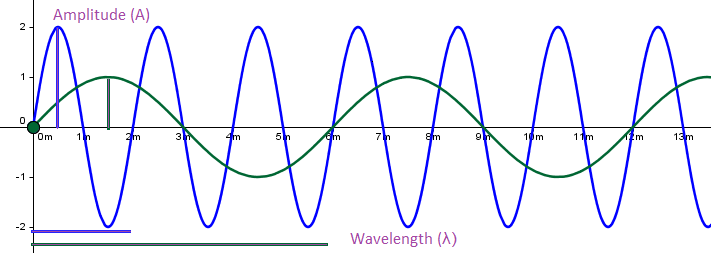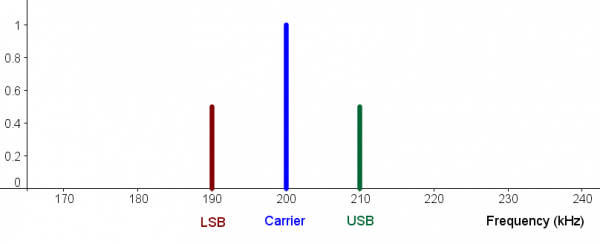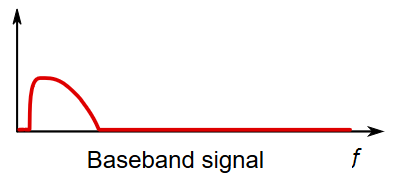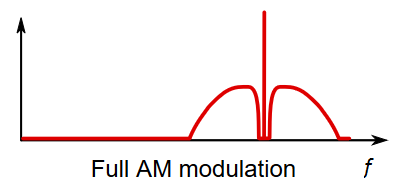This is an old revision of the document!
Table of Contents
Properties of Waves
Here we dive a little more deeply into waves and look at three ways that a “pure” radio wave (called the carrier) can be modulated to encode a voice signal (called the baseband signal): AM, SSB, FM.
But first, let's look at the general characteristics of a wave.
Amplitude, Wavelength, Frequency, and Period
Here's a good introductory video for this section:1)
Here are two moving waves (press the play button on the bottom left corner of the picture  ). What's different about them? What's the same?
). What's different about them? What's the same?
Download travelingwave.ggb
Imagine that the dots moving up and down create the waves that are travelling to the right (as we'll see later, this is kind of like how radio waves are created). Here are a few things to notice:
- The Blue wave is twice as “tall” as the green wave.
- Both waves are travelling to the right at the same speed.
- The Blue dot is moving up and down three times as fast as the green dot.
- The Blue wave is three times as compressed as the green wave.
To quantify these observations more precisely, let's look at a snapshot of both waves frozen in time.
- the amplitude is the vertical height from the centre of the wave to its highest (or lowest) point. The blue wave has an amplitude of 2 and the green wave has an amplitude of 1.
- the wavelength is the horizontal distance of one full cycle. The blue wave has a wavelength of 2m and the green wave has a wavelength of 6m.
Now imagine that the animation is in super slow motion and that the waves are actually travelling at the speed of light, which is roughly 300,000,000 metres per second: How many times does each dot go up and down in one second?
Another way of asking that question is: how many full cycles can you fit in 300,000,000 metres (since radio waves travel 300,000,000 metres each second).
- Since the blue wave has a wavelength of 2m, it'll take 150,000,000 cycles to reach 300,000,000 metres. That means that the blue dot oscillates at 150,000,000 cycles per second, or 150,000,000 Hz, or 150 Mhz
- Similarly, since the green wave has a wavelength of 6m, its frequency is 50 Mhz.
So a quick way to relate the frequency \$f\$ (in MHz) and the wavelength \$\lambda\$ (in metres) is:
\$$ \lambda = \frac{300}{f} \qquad \text{or} \qquad f = \frac{300}{\lambda}\$$
Note that the reason we're using just 300, instead of 300,000,000 is that we've cancelled 6 of the zeros so that the frequency is in MHz instead of in Hz.
Now, here's a related question: how long does it take for each wave to complete one cycle?
- For the blue wave, we know that it oscillates 150,000,000 times / second, so only one of those time would take 150,000,000th of a second, or \$\frac{1}{150,000,000}\$ s or 6.67×10-9 s or 6.67 ns.2)
- Similarly, the green wave oscillates at 50,000,000 cycles per second, so only one of those cycle would take \$\frac{1}{50,000,000}\$ s or 2×10-8 s or 20 ns.
The time to complete one full cycle is called the period (T) and is the reciprocal of the frequency:
\$$T = \frac{1}{f} \qquad \text{or} \qquad f = \frac{1}{T}\$$
Wave Addition
When two waves overlap, they add up together at every point. Here, the blue and green waves are generated and add up together to form the red wave. You can move the blue and green waves and see the result. To convince yourself that the red wave is really the sum of the blue and green waves, look at points A, B, and C. You can move the blue or green waves by sliding their phase (φ and Φ) around. You'll see that point C is always the sum of A and B.
Download waveaddition.ggb
Where do the blue and green waves need to be so that...
- the red wave is the biggest?
- the red wave is cancelled out?3)
If you press the play button on the bottom left corner, you'll see the blue wave travel to the right and the green wave travel to the left. The red wave, which is the sum of the forward and reflected waves, oscillates up and down but doesn't travel anywhere, which means it's not going into the antenna.
While the animation is running, slowly decrease the amplitude of the reflected wave (VB) and you'll see that the red wave will start moving to the right. As you do that, notice how the SWR (Standing Wave Ratio) decreases toward 1:1. At this point, there is no reflected wave and all of the energy is going to the antenna (assuming no loss in the feedline).
Modulation
Modulation is the process of “encoding” a message (be it voice or digital) onto a radio wave.
AM
AM stands for Amplitude Modulation. What this means is that the transmitted radio wave is obtained by changing the amplitude of a pure radio waves (the carrier) based on an audio signal (the baseband).
For example, let's transmit a single audio note of 10 kHz at a radio frequency of 200 kHz.4):

Before we modulate the carrier, we raise the audio signal above zero to get an envelope:

Finally, we multiply the envelope and the carrier, which gives us a wave that has the same frequency as the carrier, but an amplitude that varies like the voice signal:

So very roughly:
AM Radio Wave = (Audio Signal + 1) × Carrier Wave
Let's pause for a minute and highlight that here, we are multiplying two waves together (not simply adding them). Later on, we'll see that the electronic component that does that is called a mixer, not to be confused with an sound mixer, which does do addition.
The incredible thing about the resulting AM broadcast is that the transmitted radio signal can also be seen as the sum of three pure sine waves:
AM Radio Wave = LSB Wave + Carrier Wave + USB Wave
- LSB means Lower Side Band
- USB means Upper Side Band
This is absolutely not obvious but let's see why it's at least plausible. Imagine we start with the following three waves:
- An LSB Wave oscillating at 190 kHz with an amplitude of 0.5
- A Carrier Wave oscillating at 200 kHz with an amplitude of 1
- A USB Wave oscillating at 210 kHz with an amplitude of 0.5
Now let's add them together. This is a bit of a mess, but let's look at specific places along the waves:
- at point A, all three waves align so the sum is: 0.5 + 1 + 0.5 = 2
- at point B, the two side bands are opposite and cancel each other and only the carrier remains: 0 + 1 + 0 = 1
- at point C, the carrier is opposite the two side bands so the sum is: -0.5 + 1 - 0.5 = 0
- at point D, the same as point B is happening
- at point E, the same as point A is happening
The result is the same as final AM signal:
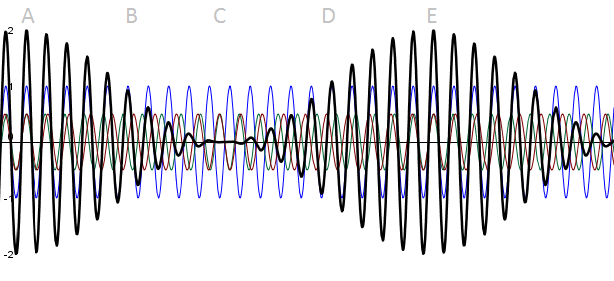
Note that the carrier has a frequency of 200 kHz just like the original carrier, but the two side bands are 10 kHz lower and higher with half of the amplitude. Notice also how the LSB Wave oscillates slower than the Carrier Wave, while the USB Wave oscillates faster.
Frequency Spectrum
An easier way to represent a radio signal is using a spectroscope, which shows the frequency spectrum of a wave. That is, instead of looking at the signal wave itself, the spectroscope shows the strength of each frequency that makes up the sum of the signal.
For example, the spectrum of our 10 kHz note transmitted over a 200 kHz carrier would look like this:
All this is saying is that the radio signal is composed of three pieces: a signal at 190 kHz with an amplitude of 0.5, a signal at 200 kHz with an amplitude of 1, and another at 210 kHz with an amplitude of 0.5.
There are three things to notice here:
- The two side bands are 10 kHz on each side of the carrier (same as the baseband signal!). It is that distance away from the carrier that represents the audio signal we want to recover.
- Most of the power is going into transmitting the carrier, which in itself doesn't carry any information, so that's a bit of a waste of energy.
- More fundamentally: even though we say that the signal is transmitted at 200 kHz, in this example, it is really contained between 190 kHz and 210 kHz. That is, it has a bandwidth of 20 kHz (210 kHz - 190 kHz). This bandwidth is regulated and depends on the band used.
SSB
One way of saving power (and reduce bandwidth) is to only transmit one of the side bands. In this example, the radio would be tuned to 200 kHz, but...
...for LSB, the spectroscope would look like:
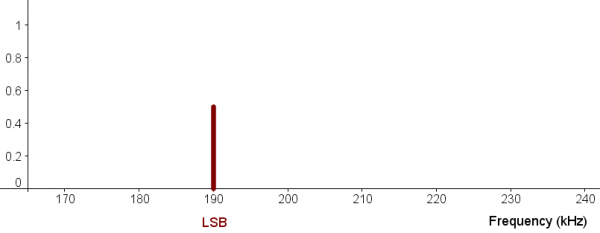
...for USB, the spectroscope would look like:
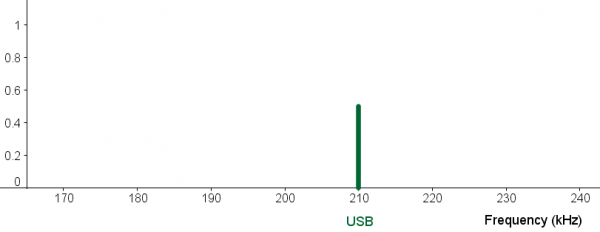
By itself, neither of these transmissions would carry the information we need (that the baseband signal was a 10 kHz note) since it's the difference between the sideband and the carrier that gives us that information. But if the receiver knows that this signal was generated by a transmitter at a frequency of 200 kHz, then the receiver can re-inject the missing carrier on its side.
This is why an AM signal is not too picky about being slightly off frequency (both the sidebands and the carrier are transmitted). But a SSB signal changes pitch if the receiver is not tuned precisely to the transmitter frequency.
In reality, the voice we transmit contains a whole group of “notes” typically between 300 Hz and 3000 Hz (music could range between 20 Hz and 20,000 Hz). A typical voice signal (baseband) could look something like this:5)
So the AM signal would look like this:
Notice how:
- the carrier is a single line in the centre because unlike the sidebands, it is a pure sine wave of only one frequency.
- the two side bands are mirror images of each, which is why it's important that both the receiver be in the same mode as the transmitter.
And finally, each individual sideband would look like this:
The two main advantages of using SSB (LSB or USB) are that:
- It takes less power to transmit the same information.
- It takes half the bandwidth.
Here's a screenshot of VA7FI's IC-7300 scope showing both modes on the same screen:
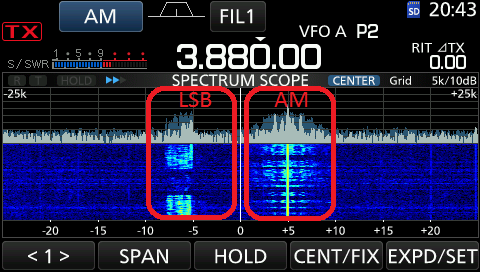
The radio is tuned to 3.880 MHz (where no one is transmitting), but there are two neighbouring conversations going on:
- one at 3.875 MHz using LSB,
- and another at 3.885 MHz using AM.
The scope shows the recent history of the radio signal (called waterfall) where the present is at the top and the past at the bottom. Blue represent a weak signal strength and yellow or red represent a strong signal strength. Here are some things to notice:
| LSB (3.875 MHz) | AM (3.885 MHz) | |
|---|---|---|
| Symmetry | The signal is on the left (low side) of where the carrier would be (at 3.875 MHz) and varies with speech. | The signal has a strong, constant carrier in the centre, and two symmetrical sides that vary with speech. |
| Bandwidth | About 2.7 kHz on the low side of 3.875 MHz | About 6 kHz (2.7 kHz on each side of 3.885 MHz, with two gaps near the carrier) |
| Pauses | During pauses, no radio signal is transmitted. | During pauses, the carrier is still transmitted. |
| Relationship | An AM signal can be understood in LSB mode because it contains the lower side band required. But an LSB signal can't be understood in AM mode because both sidebands and the carrier are needed to process the signal. | |
FM
FM stands for Frequency Modulation. What this means is that the transmitted radio wave is obtained by changing the frequency of the carrier based on the audio signal.
For example, let's again transmit a single audio note of 10 kHz at a radio frequency of 200 kHz using FM this time instead of AM:
This time, we don't simply multiply the baseband signal to the carrier (as in AM). Instead, we “compress” and “stretch” the carrier (ie, modulate its frequency) based on the baseband signal.
Here, the math is a bit more involved and requires at least 1st year calculus to understand but in a nutshell, if the carrier is \$$ c(t) = \cos(2 \pi f_c t) \$$ and the baseband signal is \$$s(t)\$$, then the FM signal will be:
\$$ \cos\Big(2 \pi f_c t + 2 \pi k \int_0^t s(\tau) d\tau\Big) \$$
If this looks like Greek to you, don't worry; the math isn't important. The key concept to understand is that the highs and lows of the baseband signal are encoded in the horizontal compression (the frequency) of the radio wave: When the baseband is high, the radio signal is more compressed (its frequency is higher), and when the baseband is low, the radio signal is more stretched out (its frequency is lower).
Optional Details
For those interested in some of the mathematical details, see this optional page.

